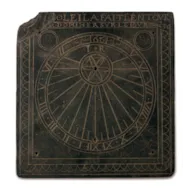A French Slate Sundial Dated 1661
A French Slate Sundial Dated 1661
The horizontal dial with roman numerals around a central compass point the gnomon missing
17th century
Size: 33cm high, 31cm wide – 13ins high, 12¼ ins wide
The horizontal dial with roman numerals around a central compass point the gnomon missing
17th century
Size: 33cm high, 31cm wide – 13ins high, 12¼ ins wide
‘Once upon a time’ every clock, large or small, required a sundial as a comparison to check that it was keeping the correct time. Sundials were relatively inexpensive to produce compared to specialised mechanical clocks and pocket watches and so are found in a wide variety of forms. Most sundials function by casting a shadow on the marked out horizontal surface; the hours marked at graduated distances, and the gnomon or style, which is parallel to the earth’s axis and pointing to the north, casts a shadow. Dependant upon the longitude every region had its own time until the invention in the mid 19th century of the electric telegraph which made it possible for a national standard time, like British Greenwich meantime, to exist and be widely known. Now almost completely superseded by the proliferation of clocks and watches the sundial only survives ornamentally in gardens.
A French Slate Sundial Dated 1661

SOLD
YOU MAY ALSO LIKE

